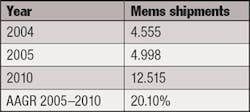The global market for MEMS microelectromechanical-systems (MEMS) devices and production equipment is expected to grow to $12.5 billion by 2010-up from an estimated $5 billion in 2005, according to market research firm Business Communications Co. Inc. (BCC) in Norwalk, Conn.
This represents an average annual growth rate (AAGR) of more than 20 percent, BCC analysts say. MEMS-one of the fastest growing technology areas-are devices that integrate mechanical elements, sensors, actuators, and electronics on a common silicon substrate.
These devices have proven to be key enabling technologies of developments in areas such as transportation, telecommunications, and health care, but the range of MEMS applications covers nearly every sector, according to BCC in a market research report, “RGB-270R MEMS: A Roadmap to Technologies and Applications.”
Global forecast of the MEMS market through 2010 (Billions of dollars)
Microfluidic MEMS was the largest segment of the MEMS market in 2004, with a market share of more than 44 percent, reflecting large sales of microfluidic MEMS inkjet heads, which totaled $1.8 billion or almost 40 percent of the global market in 2004. Optical MEMS accounted for nearly 20 percent of the MEMS market in 2004, with MEMS pressure sensors having an 18 percent share.
However, projected AAGRs in the three largest MEMS segments are generally lower than those of other types of MEMS and, as a result, these segments are expected to lose market share between 2004 and 2010, according to BCC.
On the other hand, accelerometers, which have a projected AAGR of 45 percent between 2005 and 2010, are expected to be the second largest MEMS market segment (after microfluidics) by 2010, with more than 22 percent of the market.
Gyroscopic MEMS and particularly RF (radio frequency) MEMS are also projected to gain significant market share between 2004 and 2010.
Life-science applications dominated the MEMS market in 2004, with more than 46 percent of the market. Automotive and consumer product applications accounted for most of the rest of the market, with shares of 27 percent and 17 percent respectively.
Life-sciences, automotive, and consumer-product applications should still account for the bulk of the MEMS market in 2010, collectively accounting for over 78 percent of the market.
Other MEMS application segments that are expected to grow appreciably in market share include telecommunications (whose market share is expected to grow from 4 percent in 2004 to 11 percent in 2010) and information technology (0.1 percent of the market in 2004 vs. 5.1 percent in 2010).
The BCC report contains definitions of industry terms and milestones in the development of MEMS; current and potential MEMS applications; global MEMS market trends, forecasts through 2010, market shares, and industry structure; factors that will influence the long-term development of MEMS; and profiles of the industry’s leaders.
For more information contact BCC online at www.bccresearch.com.

